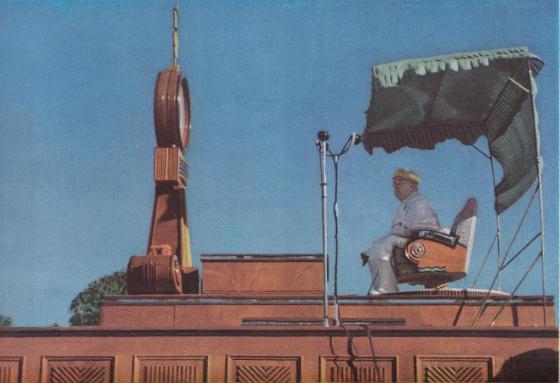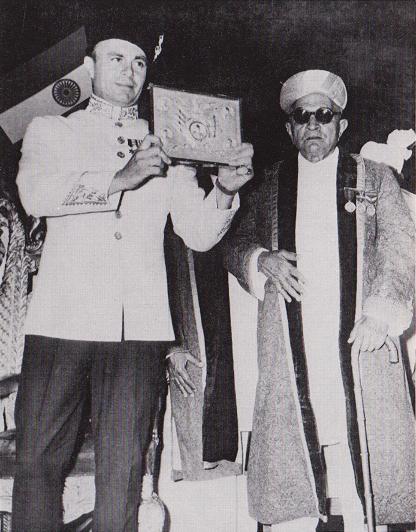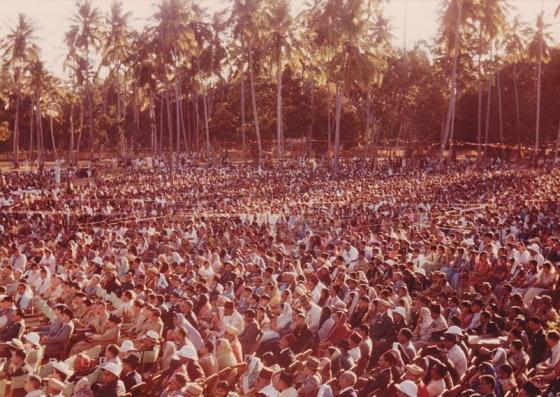I: THE GOLDEN JUBILEE – FIFTY YEARS OF IMAMAT
(1885 to 1935)
…The late Aga Khan was determined that his Golden Jubilee be marked by the launch of something that would remain forever. After much discussion,the Jubilee Insurance Company was formed and when some leaders complained that they knew nothing about insurance, His Highness replied: ‘If you want to build a factory, you don’t do it yourself, you get experts to do it’….Diwan Sir Eboo
A BRIEF INTRODUCTION TO THE JUBILEES OF AGA KHAN III
The leadership of the 48th Ismaili Imam, Sir Sultan Muhammad Shah, Aga Khan III, lasted a total of 72 years – the longest in Ismaili history. Among the most eventful years of his Imamat were the years of the Great Jubilees – the Golden, the Diamond and the Platinum – which were marked to commemorate his 50, 60 and 70 years of Imamat respectively. The Aga Khan had assumed the hereditary leadership – the Imamat – at the age of only eight years in 1885. He passed away on July 11th 1957, leaving the hereditary leadership to his grandson, Prince Karim Aga Khan (or His Highness the Aga Khan) who has been on the throne now for 52 years.

10th August 1946 - The Aga Khan at the Diamond Jubilee Celebrations in Dar-es-Salaam. Photo: David Carnegie for The National Geographic, March 1947
The Jubilees of the late Aga Khan were often described in fantastic terms by the media around the world for their pomp and the precious metals that were used to weigh him. They were equated with golden jubilees of other potentates in India, who were weighed in gold, as was customary. The Ismailis, however, saw these celebrations as a symbolic affirmation of the spiritual ties that linked them with their beloved Imam. The Imam had guided them in spiritual and temporal matters for decades and had been responsible for their material and spiritual advancement, keeping them on the course of the straight path (Siratal Mustaqim). While the first half of the 20th century resulted in significant development for the Ismaili community under the leadership of the 48th Imam, the greatest impact resulted from the proceeds that the Imam gave back to the community from the Jubilee events of weighing him in gold, diamond and platinum.

The late Prince Aly Khan displaying a Platinum Plaque which he received on behalf of his ill father, Aga Khan III, on the occasion of the Platinum Jubilee Celebrations in Bombay in February 1957.
Numerous institutions for social and economic development were established in South Asia and in East Africa. In India and later Pakistan, social development institutions were established, in the words of Aga Khan, “for the relief of humanity.” The Diamond Jubilee Trust and the Platinum Jubilee Investments Limited which in turn assisted the growth of various types of cooperative societies were formed. Diamond Jubilee Schools for girls were established throughout the remote Northern Areas of what is now Pakistan. In addition, scholarship programs established at the time of the Golden Jubilee to give assistance to needy students, were progressively expanded during subsequent Jubilees.

August 1946: Vast crowds of Ismailis from all over the world had gathered in Dar-es-Salaam for the Diamond Jubilee Celebrations of their 48th Imam, Aga Khan III. Photo: Motani Collection, Ottawa
In East Africa, major social welfare and economic development institutions were established. Those involved in social welfare included the accelerated development of schools and community centres, and a modern, fully-equipped hospital in Nairobi. Among the economic development institutions established in East Africa were companies such as the Diamond Jubilee Investment Trust (now Diamond Trust of Kenya) and the Jubilee Insurance Company (see box below for an interesting background about its origins), which are quoted on the Nairobi Stock Exchange and have become major players in national development.
The perception of the Jubilees has changed over time, even in the more popular media. What were seen as flamboyant celebrations are viewed today as celebrations that led to the transformation of the Ismaili community into a modern, dynamic and enterprising community.
THE GOLDEN JUBILEE CELEBRATIONS IN BOMBAY AND NAIROBI; THE FORMATION OF THE JUBILEE INSURANCE COMPANY
1. Bombay: 19th January, 1936

The 48th Imam of the Ismailis being weighed in gold on the occasion of his Golden Jubilee in Hasnabad, Bombay, on 19th January1936. Pir Sabzali is seen on the extreme right. The Imam weighed in at 220lbs with the gold valued at $125,000 - a vast amount for that time.
In August, 1935 Imam Sultan Muhammad Shah completed fifty years of his spiritual leadership and the Ismailis decided to pay a memorable tribute to their Imam by weighing him against gold and making a present of it, as a mark of their love and gratitude, and as an acknowledgement of his leadership which had not only brought them worldly prosperity but spiritual strength as well.
Bombay was the venue for the celebrations in India. The actual celebrations took place on 19th January, 1936 but for several preceding weeks there was intense activity in the community all over India and among Ismailis in other countries. Vast crowds in festive and solemn mood had gathered at the historic Hasanabad grounds to witness the unique occasion.
Imam Sultan Muhammad Shah and the Begum (Andrée Carron, the late Prince Sadruddin Aga Khan’s mother) arrived promptly at10.35 a.m. to receive one of the most spectacular ovations from a crowd of over 30,000 Ismailis. Every inch of space in the vast grounds was taken up. Those who could not get in lined the roads and streets nearby.
Reaching the dais, Imam Sultan Muhammad Shah took his seat on the gadi (throne) embroidered in real gold with the coat of arms of his family. To his right sat Lady Aly Shah, the proud mother, and to his left sat the Begum.
Before the weighing ceremony, Mr. Gulamali Merchant, Vice-President of the All India Golden Jubilee Committee, requested the Imam’s permission as follows:
“Most reverently and respectfully I request that Your Highness will allow yourself to be weighed in gold on this happy and auspicious occasion, and accept the gold so weighed as a humble token of our love, devotion and gratitude to Your Highness for all the unbounded bounty and benefits that Your Highness’ followers have derived during Your Highness’ Imamat for the last 50 years.”
Imam Sultan Muhammad Shah rose from his “gadi” – moved towards the weighing scale and took his seat on rich soft cushions placed for him. Although the Imam was only 5ft 5in, he tipped the scales at 220lbs and the donations added up to $125,000 – a vast fortune in 1936. The ceremony of sitting on the scales with the gold made a great impression on the British public at the time. In the west, this was seen as some sort of fantastic ceremonial, and this was because India at the time was ceremonial.
Replying to the address and weighing ceremony, the Imam said:
“I accept with great pleasure the gold my dear spiritual children have offered me and give them my loving and paternal spiritual blessings. I have decided to use the gold for the uplift of the spiritual children and appoint Mr. Gulamali G. Merchant to devise the best means of applying not only the income of this gold but the corpus also for intensive uplift work by way of all kinds of scholarships, relief by emigration from congested districts, infant welfare and other beneficial works.”
2. Nairobi: March 1, 1936

Aga Khan III, the 48th Ismaili Imam in a joyous mood at the Golden Jubilee weighing ceremony in Nairobi, Kenya, on March 1, 1936. He weighed in with the gold value of $111,248 (22,773 Sterling pounds). Photo: Motani Collection, Ottawa
The Golden Jubilee celebrations in Nairobi on 1st March 1936, were also as grand as those in Bombay.
East African Railways ran special trains called Aga Khan Specials, taking Ismaili travellers to Nairobi for the Jubilee. These trains were decorated with flags, played festive music and offered a special rate.
Before and after the Jubilee, Mawlana Sultan Mohamed Shah visited many places in East Africa and made farmans for the progress of the community.
For the Nairobi ceremony, Mawlana Sultan Mohamed Shah wore a sherwani with golden colour turban. The Begum wore green and red sari. The Jubilee message from the All Africa Jamat was presented in a very beautifully carved ivory casket. Kenya’s Acting Governor placed the first gold bar on the scale and the whole jubilee ceremony was serene and beautiful. Once more the precious metal was presented to the Imam by his murids as a token of their love and affection and once more the Imam returned the gift, with his blessings, for the welfare and progress of the Ismaili community. He had weighed in with the gold value of $111,248 (22,773 Sterling pounds)
These two jubilee celebrations were a major step in laying the foundation of the community’s economic strength.
3. A Golden Jubilee Vision of the 48th Imam Led to Establishment of the Jubilee Insurance Company Seventy Two Years Ago
| Some Glimpses into the Origins of the Jubilee Insurance Company |
|---|
In 1937, East Africa was in the grip of a world recession and the threat of world war was looming in Europe. Several businesses had collapsed and the confidence of the business community was at its lowest ebb, and many had lost their pioneering spirit. It was at this time that Sir Sultan Muhammad Shah, Aga Khan III, encouraged the East African Ismailis to start an insurance Company. All the insurance companies at that time were foreign based and it was a bold step indeed to incorporate a company locally. The first employee of the Company received a salary of 250/= (shillings) per month and the first General Manager received a salary of 700/= per month and looked forward to an annual increase of 30/=. The furnishing requirements for the Company’s first office in Mombasa comprised of 2 tables, 6 chairs, a typewriter and a single filing cabinet. From those small beginnings, seventy years ago, when the infant Company was launched with a share capital of only Shs 500,000, it has developed into a major insurance group with assets almost touching Shs 18 billion as at 2007. The Aga Khan had commented on the fact that the community was entirely reliant upon insurance companies controlled from Britain and India for its entire insurance needs with the result that significant sums of money were being diverted from Ismaili hands instead of being funnelled into enterprises that would enhance community development. A three day meeting was then held at the Jamatkhana in the then Government Road (present day Moi Avenue in Nairobi) in which the Aga Khan listened patiently to the ideas that were being put forward. He interjected with suggestions from time to time and finally a decision was made to create an Ismaili insurance company following a unanimous vote. At once, the Aga Khan asked for volunteers willing to serve as directors of the fledging company, and seven of the delegates offered their services. The directors were drawn from all over East Africa, with six from Mombasa, four from Zanzibar and its neighbouring islands and one each from Nairobi, Masaka (Uganda), and Dar es Salaam. The decision was made to operate from Mombasa, most likely because that was where several of the Directors resided. The urge to serve the community at large was strong with the result that two directors were dispatched on a tour of Kenya, Uganda and present-day Tanzania with the intention of establishing agencies in each of the major towns. It was further resolved that each Director would subscribe to a minimum of five hundred shares, and place life assurance business of Shs 20,000/= with the fledging company. In fact, Life Business combined with fire risk only, was to be the mainstay of Jubilee, deferring other forms of insurance until a later date. The search began for a suitable office in Mombasa, and this was resolved when a premise comprising of two rooms was identified in Kilindini Road (present day Moi Avenue in Mombasa). It had been previously been occupied by the South British Insurance Company Limited. On 3rdAugust 1937, the Jubilee Insurance Company was incorporated with an authorized share capital of Shs 1million made up of 50,000 shares of Shs 20 each. An Executive Committee was set up tasked with finding staff, determining salaries and generally handling all matters concerning day-to-day management and, on 30th December 1937, the Life Department commenced operations. Within a few months Jubilee had issued over 1,200 life policies and, in 1938, appointed agents in several towns throughout East Africa. On 3rd February 1939, what proved to be a momentous event in the Company’s history occurred with the appointment of the late Sir Diwan Eboo Pirbhai, to the Jubilee Board. Years later, Sir Eboo was to recall the early days of Jubilee thus: ‘The late Aga Khan was determined that his Golden Jubilee be marked by the launch of something that would remain forever. After much discussion,the Jubilee Insurance Company was formed and when some leaders complained that they knew nothing about insurance, His Highness replied: ‘If you want to build a factory, you don’t do it yourself, you get experts to do it’.” Later that year, Jubilee opened a full branch office in Kampala. In 1940, an office in Bombay, (present day Mumbai) was established and its ceremonial opening was performed by the Aga Khan’s son, the late Prince Aly Khan, who also bought 300 shares in the company. |
______________
References for this reading:
1. Hazrat Imam Sultan Muhammad Shah, by Bashir F. Ladha, published in Ilm, November 1977 ( special centenary issue), Ismailia Association, London, UK
2. Aga Khan article at www.akdn.org or www.iis.ac.uk
3. 1937-2007: A Celebration of 70 Years of Excellence. This is available as a PDF Brochure at www.jubileeholdings.com and provides more background information about the origins of the Jubilee Insurance Company.
4. Narration of Events of Golden Jubilee of Beloved Sultan Muhammad Shah (s.a.s.) 1937
by Maherunissa Dhirani published at www.ismaili.net
_____________
A note to all readers:
Please visit the What’s New page for all articles posted in this website, including the ones in the Aga Khan III series.
And do visit the Home page if you are visiting the website for the first time.
______________________
IMPORTANT: Please read the latest additions to Aga Khan III series; click below for the Platinum and Diamond Jubilee articles, photos, images and poster:
Readers are invited to visit the following AKDN links to read full text of speeches made by the late Aga Khan and to get the network activities latest updates:


https://www.britishpathe.com/video/VLVABIIMJ3SN7GCG01BOQJEHHDG7O-AGA-KHANS-JUBILEE-CELEBRATIONS-IN-INDIA/query/Jubilees
لا شيئت لا ماشاءت الأقدار فحكم فأنت الواحد القهارُ
This was a great event. The Ismaili jamat were very lucky they saw these jubilees of our 48th Imam, Sultan Mohammad Shah. We are lucky too as we have enjoyed our present Imam Shah Karim Al Hussaini’s Silver and Golden Jubilees, and Inshallah will also celebrate his Diamond Jubilee in seven years. Amen.
Al Waiz Anwar Ali Abuzar Ali Allahwala
Mashallah. This was a great event for all the Jamati memebrs who were present for these Jubilees of the 48th Imam. We have enjoyed the Silver and Golden Jubilees of our present Imam and Inshallah will also celebrate his Diamond Jubilee.